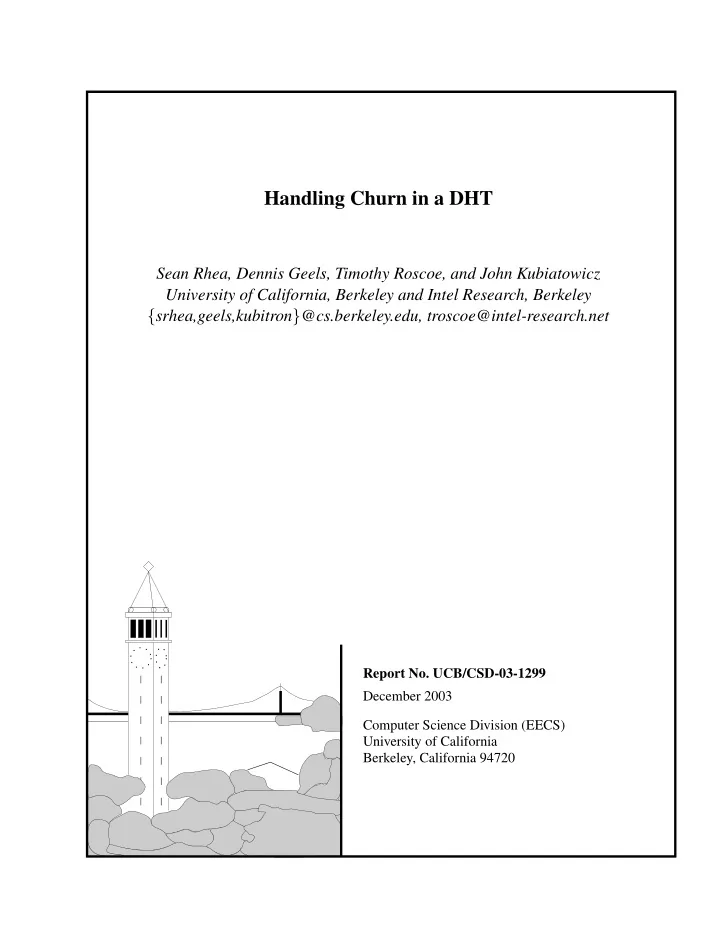

Handling Churn in a DHT Sean Rhea, Dennis Geels, Timothy Roscoe, and John Kubiatowicz University of California, Berkeley and Intel Research, Berkeley { srhea,geels,kubitron } @cs.berkeley.edu, troscoe@intel-research.net Report No. UCB/CSD-03-1299 December 2003 Computer Science Division (EECS) University of California Berkeley, California 94720
Handling Churn in a DHT Sean Rhea, Dennis Geels, Timothy Roscoe, and John Kubiatowicz University of California, Berkeley and Intel Research, Berkeley { srhea,geels,kubitron } @cs.berkeley.edu, troscoe@intel-research.net December 2003 Abstract 21]). An important result of this research is that such net- works are characterized by a high degree of churn, gener- This paper addresses the problem of churn —the continu- ally defined as the rate at which nodes join and leave the system. One important measure of churn is node session ous process of node arrival and departure—in distributed time : the time between when a node joins the network un- hash tables (DHTs). We demonstrate through experiment til the next time it leaves. Median session times as short as that existing DHT implementations break down at churn a few minutes have been observed in deployed networks. levels observed in deployed peer-to-peer systems, con- trary to simulation-based results. We present Bamboo, This paper makes two primary contributions. First, a DHT that handles high levels of churn, and discuss we survey published studies of deployed peer-to-peer net- the manner in which it does so. We show that Bamboo works to derive requirements on the churn rates that DHTs is able to function effectively for median node session must handle if they are to replace current systems. We times as short as 1.4 minutes, while using less than 900 then perform an empirical evaluation of the routing lay- bytes/s/node of maintenance bandwidth in a 1000-node ers of existing DHT implementations, and we show that system. This churn rate is faster than that observed in real these implementations are unable to withstand the short file-sharing systems such as Gnutella, Kazaa, Napster, and session times observed in the wild. Beyond a certain level Overnet. Since Bamboo’s bandwidth usage scales loga- of churn, lookups in existing systems either take exces- rithmically in the number of nodes, we expect this cost to sively long to complete, fail to complete altogether, or re- remain within the reach of dialup modems even for very turn inconsistent results. In addition, the ability of new large systems. Moreover, in simulated networks without nodes to join the DHT is often impaired. churn, Bamboo achieves lookup performance comparable Second, we describe Bamboo, a DHT that performs with Pastry, an existing DHT with a similar structure. well under high levels of churn. Bamboo achieves this goal through the following three features of its design: 1. Static resilience to failures 1 Introduction 2. Timely, accurate failure detection The popularity of widely-deployed file-sharing services 3. Congestion-aware recovery mechanisms has recently motivated considerable research into peer-to- peer systems. Along one line, this research has focused Static resilience means that Bamboo can continue to per- on the design of better peer-to-peer algorithms, especially form lookups after node failures, routing around them in the area of structured peer-to-peer overlay networks or even before recovery begins. To do so, however, it is distributed hash tables (e.g. [16, 19, 20, 23, 27]), which critical that the system accurately distinguish down nodes here we will simply call DHTs. These systems map a from those with high loads or those across congested net- large identifier space onto the set of nodes in the system work paths. Failing to notice failures quickly leads to in a deterministic and distributed fashion, a function we excessive lookup latencies, while assuming failure too alternately call routing or lookup . DHTs generally per- soon leads to congestion collapse. A combination of ac- form these lookups using only O (log N ) overlay hops in tive probing and recursive routing allows Bamboo to effi- a network of N nodes where every node maintains only ciently make this distinction. Finally, Bamboo integrates O (log N ) neighbor links, although others have explored new nodes and recovers from the failure of old ones in a the tradeoffs in storing more or less state. congestion-aware manner. Proactive recovery—where a A second line of research into peer-to-peer systems has DHT tries to react immediately to membership changes— focused on observing deployed networks (e.g. [3, 7, 11, only adds additional stress to an already-stressed network. 1
Recommend
More recommend